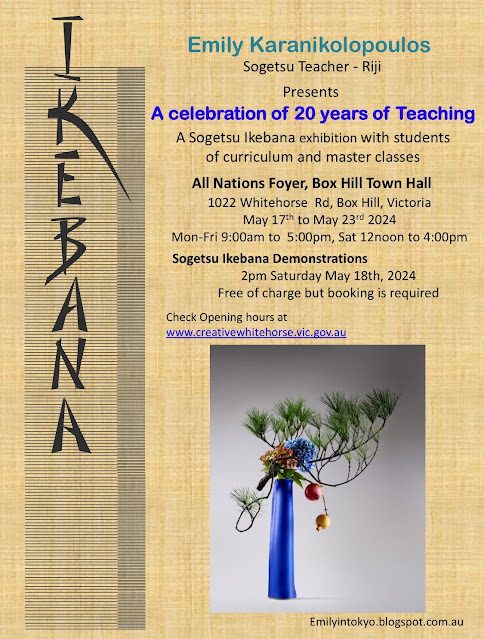Hello all,
The Melbourne International Flower and Garden Show ended its 5 day run last night. It has become a tradition for the Ikebana International Melbourne Chapter to take part in the floral competitions. This year there were 8 arrangements by members representing 5 schools of ikebana. As this is the 65th anniversary of our chapter, the theme for our arrangements was 'Celebration'. The chapter provided each one of us with two bunches of mizuhiki - one silver and one gold - as a common thread. We were to use as much or as little of this material as we pleased. Also, we were required to use a black container.
As has happened in previous years, we were, again, awarded a silver medal.
For my arrangement, above, I thought 'what better way to represent 'celebration' than with fireworks'. I used agapanthus flower inflorescences which I sprayed gold and the stems black. I wanted to represent a skyline at night, hence the umbrella grass stems wired together o represent skyscrapers. Five bunches of the darkest coloured statice filled the large, wide container and, finally, the mizuhiki cascading down from a piece of bamboo.
Lucy Papas used two large, fan palms one side of which she sprayed gold. Yellow disbud chrysanthemums and dancing lady orchids (oncidiums) were the floral materials and two bunches of mizuhiki added to the festive look.
Cym used a donut shaped container with three openings. She secured two monstera leaves through the top opening and into the bottom one. She added red anthuriums, phalaenopsis orchids and gypsophila. She wound the mizuhiki into a circle, reflecting the shape of the container and allowed some to cascade down, below the plinth.The three of us who made the arrangements, above, are members of the Sogetsu School of Ikebana.The arrangement, below, was made by Chieko Yazaki, the head of Shogetsudo koryu School of Ikebana. In her large, black urn, she used black pine (Pinus thunbergii), Chrysanthemums, oriental lilies, bromeliad and a dried branch. She draped the mizuhiki generously around the front.
Chieko's student, Magdalena O'Kane, made the next arrangement. She used a dried branch, pine, lotus pods, swan plant flowers (Gomphocarpus physocarpus), cellocias and hypericum berries. She draped the mizuhiki to follow the line of the branch.
The next arrangement was made by two members of the Ikenobo School - Joanne Huang and Angela Chau. I don't feel qualified to explain or comment on this arrangement except to say that it was quite lovely. If you look closely, you will see a small piece of mizuhiki at the bottom right side.
The arrangement representing the Ohara School was made by Felicia Huang in two ceramic suibans. She used a number of materials creating a pond-like arrangement. Again, I have to refrain from commenting as, I fear, I won't do it justice.
The arrangement by Naomi Cullen of the Ichiyo School could not be photographed very well because of its position in front of two other arrangements.And, finally, I would like to express my gratitude to my student, Lei Wang for the great job she did in photographing our arrangements. Bye for now,
Emily
























































